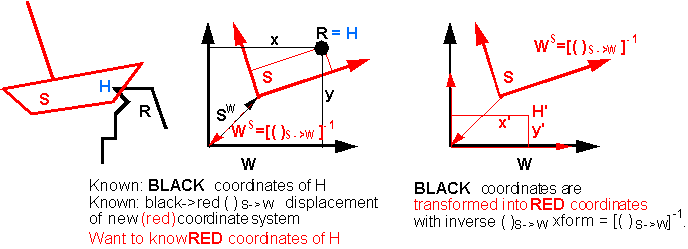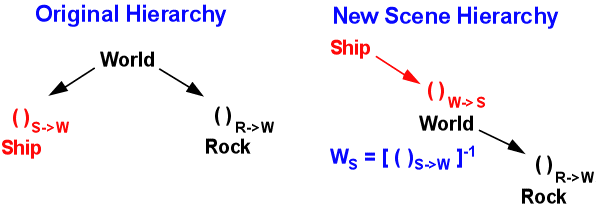CS 184: COMPUTER GRAPHICS
Lecture #9 -- Mo: 2/22, 1999.
PREVIOUS
< - - - - > CS
184 HOME < - - - - > CURRENT
< - - - - > NEXT
Preparation:
Read: Ch 5.8 "Change in Coordinate System"
Lecture Topics
Calculating Degrees of Freedom
Mental Warm-up: some more LOD questions:
Arc segments in 2D, in 3D. Cubes in 3D. 4-sided square
pyramids in 3D.
Assignment # 4
How to deal with hierarchical and dynamic scenes.
Dynamical bounding boxes; dynamical clipping.
Attend discussion session !
Study
on-line documentation !
Inheritance in SLIDE for LOD's
Inheritance in SLIDE for color, shading.
Transformations
Review: Command-Post Transforms and Turtle Walk
Start with last question on quiz. Show how easy it is if mate is moved
like a turtle.
Demo some things with foil -- e.g. Mate on Ship transformations.
Show how it could be handled in Ship's coordinates but how MateS
will cancel out and then reinserted,
thereby practically amounting to the same string of matrices.
Reinterpretation of Coordinates in a New Framework
Another semantic view of a transform matrices: re-interprete a given point
in a new coordinate system:
CASE 1: Ship (at SW) hits rock, gets Hole (H) in known location
of Ship's hull: HS = RS;
==> determineRock (R) position: RW = RS ( )S->W
; {R, H = row vectors! }
This is really just as before: We place the Hole hierarchically in
the World via Ship.
CASE 2: Now we ask a different question: Given the Ship position
(SW), and the Rock position (RW), both in the World,
==> determine where the Hole will occur in the Ship's hull: RS=HS
==> or: what vector RS together with ( )S->W
will give the proper RW ?
We want: RW = RS * ( )S->W
-- to solve: OUTSIDE-multiply both sides with [ ( )S->W) ]-1
==> RW * [ ( )S->W ]-1 = RS
* ( )S->W * [ ( )S->W ]-1
Thus: HS = RS = RW * [ ( )S->W
]-1
==> Hole position = Rock in S coord. = Rock in W coord. * [ (
)S->W ]-1
This has a geometric representation: Fix Hole in Shiphull (in yet unknown
location),
Move Ship (red) back to origin [ ( )S->W ]-1
, -- and there read off the coordiantes.

Relative positions between objects in different subtrees in hierarchical
scene trees.
Interpretation with a modified scene hierarchy:

This can be used very generally:
Whenever we go against the arrows in the scene hierarchy,
we use the inverse of the transformation matrix.
This will be needed when we try to determine the relative positions
of objects in different subtrees of a large scene tree:
e.g., what does a camera held in the hand of a man in a pickup truck see
of the face of another person riding a motorcycle ?
Next time we will have to find out how to obtain the inverse matrices.
New Homework Assignment:
ASG#4:
"2D Polygon Clipper"
DUE: Saturday 2/27/99, 11:59pm.
TO BE DONE with a NEW PARTNER !
--> Next
Lecture
<-- Up to CS
184 HomePage
Page Editor: Carlo H. Séquin